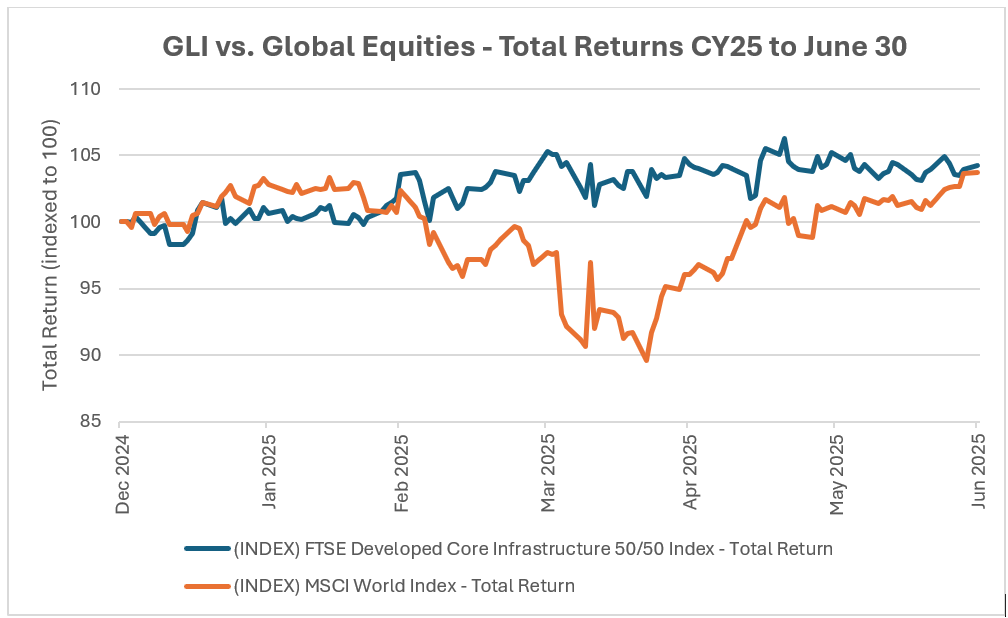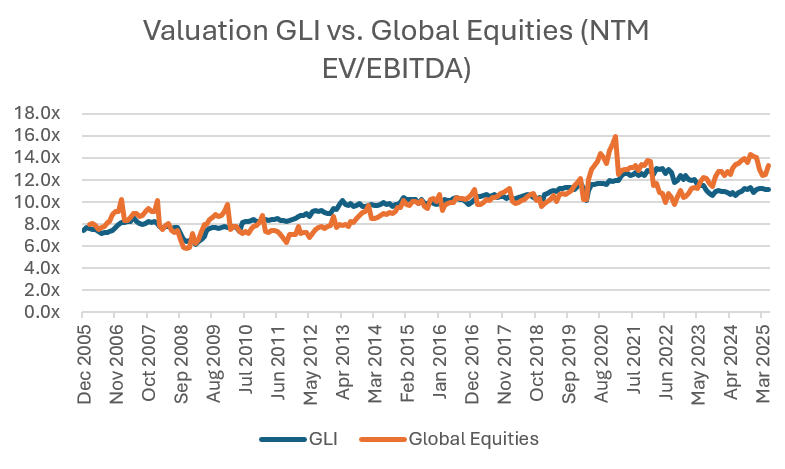The opportunity driving 8-9% average earnings growth in the next three years
The headlines suggest investors are turning back to risk assets, tired of constant uncertainty and moving on with life. Those same investors shouldn’t forget defensive options. Especially when those assets are looking as attractive as global listed infrastructure appears in the current market.
Sarah Lau, portfolio manager for the Resolution Capital Global Listed Infrastructure Fund, notes that the sector is currently trading at a 16% discount to global equities on an EV/EBITDA basis, and its earnings have been largely in line with the performance of global equities.
“Global listed infrastructure, as represented by the FTSE Developed Core Infrastructure 50/50 Index (AUD unhedged) delivered total returns of 3.1%, comparable with the 3.7% returns of global equities as measured by the MSCI World Index (AUD unhedged),” she says.

Source: Factset, FTSE. GLI as represented by FTSE Developed Core Infrastructure 50/50 (AUD unhedged). Global Equities as represented by MSCI World Index (AUD unhedged)
She adds that this performance came without the same drawdown experienced by global equities between February and April. She’s expecting strength to continue.
In this interview, she discussed the performance of global listed infrastructure, how Resolution Capital has managed this in the portfolio, and where she forecasts 8-9% EBITDA average growth over the next three years.
Global infrastructure in the wake of tariffs and other uncertainty
It’s been a wild ride for investors in equities this year, but Lau notes that it isn’t the same story for infrastructure, highlighting that geopolitics have had a limited impact on the sector as a whole.
“The transport sub-sector was more affected by tariffs, particularly assets enabling freight transportation. North American railroads, the most freight-sensitive sub-sector within global listed infrastructure, may face short-term volume impacts due to shippers manoeuvring around tariffs, but should benefit from near-shoring in the long term.
Other sub-sectors, such as U.S. utilities, have quantified the impact of tariffs at low single digits, with no effect on earnings. European leaders have increased commitments to internal infrastructure investments, offering potential upside,” she says.
Lau explains that the sector is able to offer insulation from geopolitics due to its role in meeting critical societal needs, resulting in ongoing strong demand and the ability to pass through inflationary increases.
With market volatility heightened, Resolution Capital increased positions in European utilities and broader infrastructure and decreased its US asset positioning.
“For instance, we increased our position in Italian utility, Italgas (BIT:IT), due to our conviction in the management team’s ability to deliver better-than-expected earnings growth, and this thesis has played out for our portfolio,” Lau says.
She adds that the portfolio continues to be overweight electric utilities, where the team sees benefit from increasing electricity demand and energy transition. It is underweight utilities in the US Northeast, because “energy bills take up a higher proportion of household income and there is less overall growth in population and businesses to spread the increasing cost base.”
A good entry point for investors
The below chart demonstrates that the global listed infrastructure sector has typically traded on par with global equities, but is currently at a 16% discount.

Source: FTSE and Bloomberg
GLI as represented by the FTSE Developed Core 50/50 index and Global Equities as represented by the MSCI World Index
“This implies that the defensive monopolistic qualities are not fully valued by the market,” Lau says, adding, “we believe that the earnings for the sector are accelerating because of key thematics including the energy transition, energy security and digitisation.”
Lau believes this is an attractive entry point, reminding investors that the sector is typically high quality. While Australian investors are typically exposed to the Australian high-quality sector, Lau finds that there are often better valuations and growth prospects internationally.
She cites the examples of Spanish airport monopoly AENA (BME: AENA), which trades cheaper than Auckland Airports (ASX: AIA) on roughly half the EV/EBITDA multiple, or US key gas pipeline network Kinder Morgan (NYSE: KMI), which is similar to APA Group (ASX: APA).
“Kinder Morgan is underpinned by natural gas volume growth in the US of ~30% through to 2030 due to strong power demand in the US,” Lau says.
Further to the valuations in the sector, Lau sees strong future growth and attractive income yield going forward.
“We forecast a 3.6% dividend yield for the sector, which is attractive within a global context,” she says.
The trends to watch: energy transition, energy security and digitisation
Lau believes the market has adequately valued the size and duration of infrastructure drivers, such as the energy transition, energy security, and digitisation.
“Our current forecasts are for 8-9% earnings (EBITDA) average growth over the next three years, which is very attractive versus broader equities,” she says.
She highlights electric utilities as being the biggest beneficiary of the theme, particularly as a bottleneck in the race for AI dominance and advanced manufacturing.
“In particular, utilities in the south east of the US, including the likes of Southern Company (NYSE: SO), Entergy (NASDAQ: ETR) and Duke Energy (NASDAQ: DUK) have seen no slowdown in the enquiries from potential large-scale energy users,” Lau says.
While investors may feel that the energy transition is less front of mind now that US policies have moved away from renewables, Lau believes that it has simply changed the timing for renewables and “the overall size of investment and therefore, earnings growth for electric utilities has shifted up.”
Investment into this space is becoming increasingly critical, with energy security a major focus. You need only consider the blackouts across Spain in April as an example of the urgency in building resilient energy sources.
While managing demand and security means massive investment on the part of utilities, Lau explains that investors need not fear what this might mean for returns.
“Electric utilities are in a unique position as monopolies, as they earn a reasonable return on investments and capex spend. Thus, there is a positive correlation with investment and earnings-per-share (EPS) growth,” she says.
Global listed infrastructure in a nutshell
Alongside its attractive valuations, Lau believes investors should also consider global listed infrastructure as a diversification tool offering defensive qualities and for exposure to some of the biggest megatrends of our time.
“Global listed infrastructure’s underlying assets are uniquely positioned monopolies providing essential services which we believe are now at an inflection point and will capture an outsized amount of the growth forecast from long-term megatrends,” Lau says.
With Australians well attuned to incorporating the likes of Transurban and AGL, it could be time to think global.
5 topics
3 stocks mentioned
1 contributor mentioned


